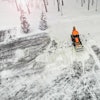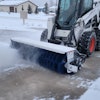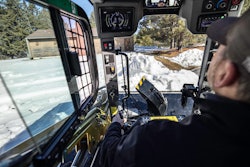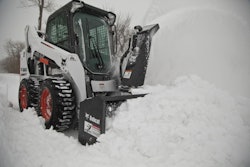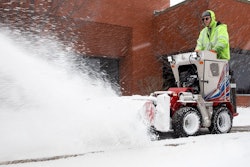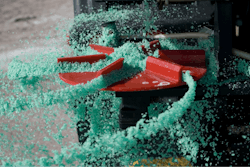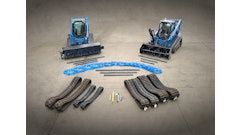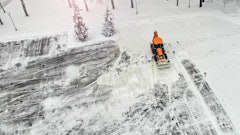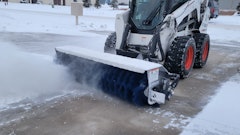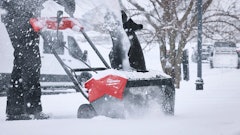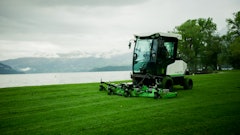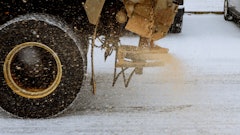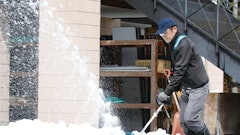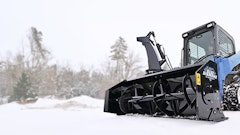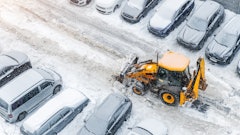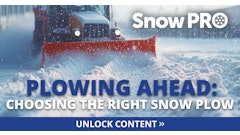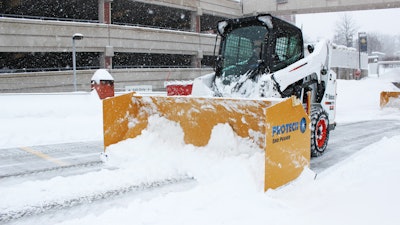
For commercial snow contractors, there are three types of off-road construction machines that are the staple of the industry: The wheel loader, the skid-steer or skid-steer loader, and the compact track loader (CTL). All three can be outfitted with buckets, brooms, pushers, and plow blades, and perform exceedingly well in snow removal operations.
Both the skid-steers and CTLs are compact pieces of equipment that pack a fair amount of power but can turn on a dime and will maneuver well in tight places. Where these machines differ, however, is primarily in the way they traverse ground. Skid-steers have wheels and tires, while compact track loaders operate via high-floatation rubber tracks.
When it comes to evaluating the difference in performance between skid-steers and CTLs, the choice is not necessarily obvious and may simply come down to an operator’s personal preference rather than the requirements of the parking lot being cleared. One should also consider what that contractor does during the warm months. As an example, landscapers are known to slightly prefer CT’s over skid-steers for their summer work, whereas paving contractors may prefer a skid-steer for their warm weather activities. It makes sense that they would want to utilize these same assets for snow. Either machine will perform comparably.
Bear in mind that both skid-steers and CTLs come in different sizes. The smallest of these categories will limit their value, sometimes significantly, in the snow world.
For most of the serious commercial snow contractors, if the lot is large enough, you need to use wheel loaders.
 For most of the serious commercial snow contractors, if the lot is large enough, you need to use wheel loaders.Arctic Snow and Ice Control
For most of the serious commercial snow contractors, if the lot is large enough, you need to use wheel loaders.Arctic Snow and Ice Control
Skid-steers or CTLs are ideal for HOAs and some of the smaller parking lots being cleared by commercial snow removal operations. “When it comes to the skids and compact track machines,” Peters says. “We need them as well for tight work where loaders cannot go, including sidewalks in many cases. Strip malls, or a mix of restaurants and retail with several islands or other details to work with, are ideal for the smaller machines.”
“It also depends on how you want to operate your business,” Peters says. “Some of your smaller snow contractors thrive on the small stuff. They need to be able to move their machine from site to site via a pickup truck and a trailer. In that case, the skid or track machine is exactly what they need. Other companies bill their clients on time and material. If that is the case, efficiency is not their goal. There are also some clients who are not as concerned about pedestrian traffic and can be satisfied with a less timely level of service.”
Overall, there is no clear winner if a skid-steer, CTL, or wheel loader is better for snow removal. Each has advantages and disadvantages.
“You're going to want to have all three, depending on what you're working on,” Peters says. “We have over five hundred pieces of equipment out there utilized in some capacity or another. Of course, without a great pusher, are you really going to be able to be happy with the work you do?”
Selecting a plow
For a skid-steers or CTLs, snow removal professionals generally are looking at a pusher versus a blade to scrape the snow.
To draw the distinction between pushers and plows, a plow is an angled blade that guides snow to either side of the driver. A pusher is a containment or box plow with side wings that contains a great quantity of snow which it moves from one end of a parking lot to the other, where it is piled up out of the way.
To select the proper snow pusher, a contractor must first analyze the existing fleet and select the size pusher that will match well to that machine. Each model of pusher is meant for a particular size of equipment – meaning one designed for a large loader would likely not work on a small skid-steer or CTL. Local dealers aid contractors looking to purchase the right pusher for his or her equipment.
“At Pro-Tech we believe that simplicity is key in the world of snow and ice management,” says Ryan Marino, marketing manager, Pro-Tech. “There are lots of great options in the market, but hydraulic snowplows take experience to run, so yes, they are options for some operators but not everyone. Pro-Tech prides itself on building a simple and very durable plow that provides superior surface outcome.”
 To select the proper snow pusher, a contractor must first analyze the existing fleet and select the size pusher that will match well to that machine.KAGE
To select the proper snow pusher, a contractor must first analyze the existing fleet and select the size pusher that will match well to that machine.KAGE
“The pusher is doing all the work in the parking lots because of its ability to move a large volume of snow from one end of the lot to the other, and then stack it at the other end,” Peters says. “That’s what customers want, they want you to remove the snow and get all the parking spaces free.”
Snow pushers come in a variety of sizes, with the smallest measuring 6 feet to larger units extending well over 25 feet. Contractors can minimize equipment costs by analyzing their existing fleet and then fitting with the appropriate-sized pushers.
For example, a small skid-steer could be outfitted with anything from a 6-foot up to a 13-foot snow pusher and be ready for use, depending on the brand.
“The right size plow is defined by the locations which you plow,” says Josh Nelson, marketing generalist, KAGE. “We always suggest taking measurements of tight areas to make sure that operators will easily be able to plow at higher rate of speed.”
He recommends going one size smaller than anticipated to allow operators to move faster and clear tight areas quickly and safely.
“Having the correct size plow also allows the operator to clear required areas without hitting objects that can not only cause damage to equipment, but also injure operators,” Nelson says.
Marino says smaller pushers are easier to maneuver while larger-sized units can be more difficult.
“If an operator is using a larger Sno-Pusher it will move more snow but there are smaller margins for error,” he says.
Ideally, on a commercial lot, you start at one end and push the snow all the way to the other end and stack it into large piles.
“If you don't have the right pusher, what you have to do is stop and have mini piles, that you then come back and chop that up,” Peters says. “Be sure you have a quality pusher that can move enough snow that it will make it to the end of a run without stopping.”
Know Your Customer
While the pusher remains the primary interest, the type of accounts and surface being serviced will also be a primary defining factor in selecting a plow for a skid-steer.
“Many contractors handle a variety of accounts including large open lots, small commercial, large residential and standard residential,” Nelson says.
He suggests that in large open lots, small commercial, and main drags at large residential locations it is key to have a blade and pusher combo.
Some snow removal contractors do utilize hydraulic, angled plows on a skid-steer and end up creating windrows and then return and try and determine how to get it to the side of the parking lot. With a blade, an operator is forced to push it off to the side and leave it. For a minor snowfall, that tends to not be an issue. However, with a more substantial snow fall, multiple parking spaces can be lost to the piles of snow.
At KAGE, Nelson says they utilize a 2 in 1 system on their Snowfire snowplow box system, offering a blade with a detachable KAGE box. “This allows operators to use an angling plow blade to windrow and back drag, then attach the box (pusher) in seconds without leaving the cab to move large amounts of snow to piles where the operator can stack,” he says. “We also suggest adding back drag kits and poly cutting edges in residential locations as well since it is easier on high value substrates and is quieter.”
On Edge
The surface the operator will be primarily plowing on comes into play as different containment plows feature different cutting edges.
Cutting edges, whether rubber, hardened steel, or carbide, are a topic that attracts a lot of attention, with some manufacturers attempting to differentiate themselves based on their edges, even though they may not be particularly unique.
Asphalt or pavement is the preferred surface because it's the gentlest on the cutting edges. Concrete tears down the edges like sandpaper and decorative cobblestone or something specialized usually calls for a rubber edge.
“When selecting a Sno-Pusher, the type of snow should also be factored in,” Marino says. For example, when plowing on a surface like asphalt or pavement, he says Pro-Tech’s Fusion Edge (rubber/steel hybrid), or steel edge are options. Rubber edge snow pushers will clean wet heavy snow while icy and heavily trafficked conditions will need more aggressive scrape from a steel or Fusion Edge.
Depending on the surface, it is important to match the equipment to your needs. Different plowing surfaces and operator training also make a difference.
“You cannot exchange cutting edges on the job, so blade decisions need to be based on the surfaces being tended and not the type of snow you might receive. It is nonsense to think otherwise,” says Peters. “We have made the decision to lean toward the standard AR400 steel cutting edge in nearly all of our accounts due to its overwhelming versatility and reliability. We will use rubber on rare and specific instances that require it, such as parking decks, cobblestone, etc. Otherwise, it will not have the necessary scraping capability to get the job done, and the extra salt required to clear a lot will be cost prohibitive.”
 A small skid steer could be outfitted with anything from a 6-foot up to a 13-foot snow pusher and be ready for use, depending on the brand.Arctic Snow and Ice Control
A small skid steer could be outfitted with anything from a 6-foot up to a 13-foot snow pusher and be ready for use, depending on the brand.Arctic Snow and Ice Control
“Concrete will certainly wear down a blade much faster than asphalt, and carbide might be appropriate if you are plowing mostly concrete,” Peters says. “However, under normal conditions on an asphalt surface, AR400 steel generally works the best and provides the best value. If we find that an operator is going through cutting edges at an accelerated pace, we generally know that some additional operator training is in order.”
Operator experience
One of the first things new operators learn about pushers is the hitch design. A snow pusher is picked up and set down hundreds of times during a snow event. Typical hitch designs force the operator to manually adjust the plow each time it is dropped. When the boom arm comes down with the plow, the weight of the plow lifts the front wheels lift off the ground, limiting traction.
“You have to have considerable experience to keep the machine level when you're dealing with a pusher that does not have its own independent suspension such as Arctic’s patented Slip Hitch,” Peters says. “Add hardpacked snow and a rubber edge and you might as well not even show up for work.”
 One of the first things new operators learn about pushers is the hitch design. A snow pusher is picked up and set down hundreds of times during a snow event.
One of the first things new operators learn about pushers is the hitch design. A snow pusher is picked up and set down hundreds of times during a snow event.
Peters agrees.
“When Arctic designed the Arctic Sectional Sno-Pusher it was for our own use, so we could solve the problems that were holding us back,” he says. “It was this pusher that allowed us to do parking lots in half the time of any competitor’s product and save 50% on salt due to how clean we scraped.” The efficiencies and salt savings allowed Arctic to grow its service business to be the one of the largest in the country.
“As a bonus, we’ve never destroyed a plow on hidden obstacles, which no other pusher can truthfully claim, and our 20-year-old pushers are still in service,” Peters says. “Finally, with our Slip Hitch, inexperienced operators could be trained to plow like experts on the first day.”
On track
Either skid-steers or CTLs are viable options for snow removal from a traction perspective.
Wolf Paws from Snow Wolf, Kage Klaws from Kage or Pro Cleats from Pro-Tech are among the skid-steer snow tire options on the market. In most cases, a narrow profile places more weight per square inch on the ground and traction is also increased with a tread pattern and rubber compound formulated for cold weather.
“Generally, skid-steers come with either construction tires or tracks,” Marino says. “Skid-steer snow tires such as the Pro-Tech Pro Cleats offer a considerable amount of better traction leading to a more efficient operation.”
Nelson adds that snow or turf tracks likely provide the best traction. However, many companies do not have a tracked machine.
“If you have a skid-steer with tires, it is important to have tires that are designed for the conditions that you operate in,” he says.


